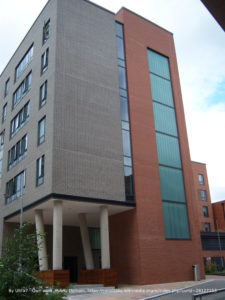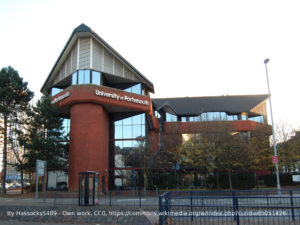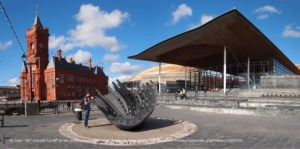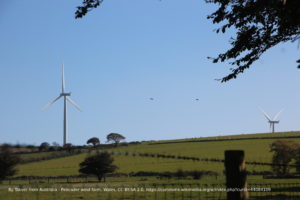
Student Housing

Welcome to Student Housing: The Energy Efficiency Podcast – episode 19, the podcast that brings you a mix of energy efficiency news, products and tips all year round. We’re interested in profiling people and products involved in promoting energy efficiency habits, products and information, so please do get in touch if you have something to contribute.
This week: in a change from our plans to begin a review of energy efficiency in various areas of food and drink production, we’ll instead continue examining energy efficiency in student housing. We’ll also talk about the Three Per Cent Club, and renewable energy in Wales – that’s the country.
Building regs proposal
But before we begin, this week a furore erupted over local authorities’ powers to set tougher buildings standards than Westminster. As we saw in our feature on new build standards in episode 6, under Part L of building regs, local authorities have the power to enforce a tougher building standard than the government has specified. Now, however, the government plans to remove these powers as part of achieving the Future Homes Standard. Many councils across the UK have taken advantage of this provision to provide low energy housing.
Last week, ministers released plans to update Building Regulations so that housebuilders would be forced to build greener homes. This sounds good in theory but of course there’s a catch: the government views its own plans as a sufficiently big step forward that no additional powers are needed at local level. The government considers that potentially varying standards across the country confuse housebuilders and make green building more expensive. At the moment these plans are due to be brought into force either next year or in 2025.

This seems a retrograde step, and Mayor of London Sadiq Khan certainly sees it as a blow to his plans for London becoming net zero by 2050. He opposes the plans and sees it as watering down of green building plans.
As we saw in episode 6, the government has a history of this. 230 councils in the UK have declared a climate emergency and many, including Liverpool, Nottingham and Bristol, have set net zero targets well ahead of the government’s. Removing their powers to insist on the very highest energy efficiency standards will be enormously unwelcome.
The proposals are currently at the consulation stage. We’re including a link to the government’s own verbiage on this. You can respond to the document via that link. The consultation period ends in January 2020 but if you want to respond don’t delay as it will no doubt get buried under Brexit and Christmas and so on.
Energy efficiency in student housing
Last week we talked about Student Switch Off, the NUS-run initiative to encourage students into good energy saving habits in their three years living away from home. It wasn’t intended to be the start of anything, but since then articles keep popping up about the good and bad about student housing itself, and we felt that the moment was right for a closer look.

The BBC ran an article last week about students left stranded as the accommodation they had expected to move into was unfinished. It gave an example in Portsmouth where a girl had to be put up in a hotel with no cooking facilities and away from her course mates.
Accommodation not ready
Students have been arriving from overseas to discover that their room isn’t ready. At the same time as not being able to get into their rooms, students are being asked to pay for the non-existent accommodation, in some cases with a small compensation payment made to them. 22 private blocks of student housing in cities including Swansea and Lincoln are unfinished as term begins, and that amounts to 1/3 of all the student accommodation that’s going up just now.
Unregulated
In the case of Portsmouth University, it’s as angry as anyone else as this is private accommodation it has no control over. It appears that this sort of construction comes with little accountability or consumer protection. It isn’t covered by Universities UK’s code of conduct because it is private development. The Office for Students doesn’t have powers to regulate it either. The government sees universities as autonomous and says that it doesn’t involve itself with student acommodation. The developer of the building in Portsmouth blames the contractors.

In Glasgow, students have moved into flats that haven’t yet undergone a fire audit. The developer hadn’t obtained a certificate from Glasgow City Council to confirm that the building was finished, and without that the audit couldn’t be done. That didn’t stop the developer from allowing students to move in. There’s no gas certificate either. The fire service has been called out on average once a month to the block, mainly for cooking-related incidents.
In their defence, the developers felt they had a responsibility to house the students in a building that they were sure met regulations, and that the alarms went off because sensors were too effective. The situation is under review by the council.
Reports
So against that backdrop, what can students expect in the way of quality, energy efficiency and comfort once they are able to move in? Last year Knight Frank and UCAS released a survey of the views of 70,000 students on the factors influencing their choice of accommodation. Clearly this report is intended for the developer and landlord market, but what it leaves out is revealing. There is not one single mention of energy efficiency. On the basis that the students could only answer the survey questions asked, presumably neither Knight Frank nor UCAS considered energy efficiency worth asking about.
Another Knight Frank report issued this year looks at the commercial opportunities of student housing without any mention of the value of energy efficiency to the market. Set against this the view from student group Save the Student that poor living conditions are just accepted as part of the student experience in the UK.

Little quantified information is available on the energy efficiency of the vast majority of legacy student accommodation in the UK. Anecdotally we know it can be expensive on heating and hot water, chilly and damp. Every report I’ve found researching this feature focusses on the cost and availability of accommodation and the commercial opportunities for investors. There are some good news stories, but usually these are around new developments that are going up and only a minority of students will live in those.
New developments
Future students of the University of Leicester might find themselves living in one of seven new blocks with an emphasis on energy efficiency. These are being delivered as part of a wider contract including teaching and office facilities. Energy efficiencies will be achieved through a number of measures, including solar panels, a gas-fired combined heat and power system, and LED lighting.
The developer behind the project, ENGIE, has created this type of housing before. ENGIE is a big French company with many operating divisions and a dedicated UK and Ireland arm. Originally a power company, ENGIE now concentrates on renewables and services. As well as providing new student accommodation, ENGIE retains and refurbishes older facilities. Refurbishing a grade II listed building forms part of the works at the University of Leicester. ENGIE has recently won a contract to provide a similar scheme for the University of Kingston in London, focussing on redesign and refreshing with a focus on optimising energy efficiency.
The University of Cambridge is about to construct passivhaus graduate housing for King’s College in a conservation area. Sadly a row of art deco houses have fallen casualty to this development as the level of work needed to them would have left them without many original features. The architect describes the proposed timber-framed replacements as “designed to last”, which is reassuring. Interestingly, given the different building standards we’ve looked at lately – BREEAM, LEED and WELL – this project has been assessed against a range of measures. These include “excellence in health and wellbeing; landscape and nature; water; materials and waste; community and neighbourhood; and construction impacts.”
Another approach is the ZEDpod. ZEDpods describes its housing as “a fast, low cost, sustainable solution for expanding on-campus accommodation,”. ZEDpods are designed to go on unused bits of land and above car parks. It goes up in just a few weeks and crucially is a low energy solution that goes so far as to describe itself as zero carbon. The units are fully fitted out during construction, and can come down as quickly and simply as they go up. They can even be relocated. The idea is to afford universities flexible accommodation options, but it also affords energy efficient student accommodation on a less grand scale than major developments.
ZEDpods are modular housing made up of prefab elements. They are highly insulated and triple glazed, maximise daylight and use heat recovery ventilation. They also feature solar panels and heat pumps for hot water. The first units in the UK are going up on college land in Bedford but rather than for students these are for affordable housing for Bedford’s nurses, teachers and firefighters. The land is being provided by Central Befordshire College, which intends to use the construction as a teaching opportunity on eco-friendly building methods. Further ZEDpod developments are at the planning stage.
Lottery
Ultimately student housing in the UK remains a lottery. With students potentially going to the other end of the country to study, much has to be taken on trust for first year accommodation. The vast majority of student housing wasn’t built to good energy efficiency standards and landlords have little incentive to upgrade their properties all the while that the investment market doesn’t prioritise or rewardsenergy efficiencies. It’s encouraging to see developers featuring energy efficiency in new developments, but ultimately this is a drop in the ocean. Student housing is an area where there is a great deal more to be done if all our students are to spend their university years in affordable and comfortable accommodation.
The Three Per Cent Club
Hello Kevin
Hello. What are we talking about this week?
Haven’t been there. Three per cent of what?
Three per cent annual efficiency (this is nothing to do with the American militia movement). The Three Per Cent Club is a group of governments and supporting organisations working together to make a three per cent improvement in public energy efficiencies.
What’s a supporting organisation in this context?
Financial institutions such as the European Bank for Reconstruction and Development, bodies such as the IEA, and some private sector bodies. They agree to set the same goals as the governments. They work together across countries to develop policy and implement projects by getting their hands dirty.
Who’s in the club?
As of last month there are 15 countries including the UK, Argentina, Denmark and Honduras. The 3% target was announced at the UN Secretary-General’s Climate Action Summit. It’s intended to meet climate goals and enhance economic prosperity, and will create sufficient annual energy efficiency improvements to meet the Paris Agreement.
What’s brought this about?
It was inspired by a report put out by the International Energy Agency, titled Energy Efficiency 2018.
What did that have to say?
Its core finding was that the energy demands of rising economic activity are outpacing energy efficiency improvements. At the same time though efficiency policies have made a significant impact. The report looks at what could happen if countries worked together to decouple economic development from rising energy consumption.
Download that report. Be aware it’s 174 pages long.
The report asks these questions:
What is the current rate of global progress on improving energy efficiency?
What opportunities are available to scale up global efforts on energy efficiency to 2040?
What multiple benefits does energy efficiency deliver, and how might these grow in future?
What are the current energy efficiency trends in the transport, buildings, and industry sectors?
What are current levels of investment in energy efficiency and by how much does investment need to increase in future to realise the opportunity of the Efficient World Scenario?
What innovations in energy efficiency finance and business models could be expanded to drive greater levels of energy efficiency investment?
The report comes out, and then why did the Three Per Cent Club come about on the back of it?
The report showed that energy efficiency progress has slowed since 2015 due to the demands of growing economies. Against that backdrop, the rationale of the three per cent club is that although there is massive scope to save energy globally – energy efficiency has been described as a ‘global resource’ – many countries are struggling to really get to grips with it and realise the benefits. By working together and sharing resources, these countries expect to support energy efficiency globally. Essentially, right now, global energy demand is rising and opportunities are being missed.
Inefficiencies are snowballing which causes problems later on. How will the three per cent club help other countries remove these inefficiencies?
By getting countries to make specific energy efficiency commitments. At last month’s Climate Week, Eric Rondolat of Signify addressed the General Assembly of the UN and exhorted more countries to join and to revise their national commitments.
What’s Signify?
They are providers of LED lightbulbs and used to be known as Philips Lighting. Fitting LED lighting is one of the most effective quick-fix energy efficiency improvements.
According to the IEA website if savings had been properly maximised, in the last year the planet could have used 2.2 million barrels of oil fewer PER DAY. There are a few other statistics on potential savings on the IEA website if you want to look those up. Essentially the IEA wants to reverse the current trend.
So have more output for less energy use?
Yes. The IEA has come up with something called the Efficient World Scenario. This world had 20% more people, 60% more building space and double the GDP, but only a marginal energy increase. This scenario also meets the UN’s Sustainable Development Goal 7.
Goal 7: Ensure access to affordable, reliable, sustainable and modern energy for all. This in turn underpins the Sustainable Development Goals which cover areas including healthcare, eradication of poverty, water supply and industrialisation. The IEA states that its Efficient World Scenario is cost-effective and based on existing technologies.
What kind of savings could we see in this scenario?
Initially there would be a peak in emissions, but by 2040 emissions would be 12% less than today. It would cut air pollutants including sulphur dioxide, nitrogen oxides and particulate matter by 1/3 compared to today. Less polluting cooking methods would remove a million household air pollution deaths annually by 2040.
The onus looks to be falling on emerging economies to grow more sustainably. Can the worst offenders make the biggest savings?
Apparently so. The IEA scenario sees them become 50% less energy intensive. China and India would account for 1/3 of worldwide energy demand by 2040 but also over 1/3 of total energy demand savings. That’s equivalent to saving of $500 billion in fossil fuel imports.
And it’s in putting together the nuts and bolts to achieve these sorts of savings that the Three Per Cent Club can help?
Yes. The idea is that good policy in one country forms the basis for good policy in another. It comes down to sharing good ideas and making commitments.
It has knock-ons in other areas too – energy security, job creation, for example.
Apart from the fact that we have no choice but to reduce energy use, considerations such as energy security and job creation are a big upside. We have to hope that the actions of the Three Per Cent Club will bring this home to countries struggling to achieve energy savings so that they can start to feel the benefits.
Renewable energy in Wales

The Energy Saving Trust and Carbon Trust together lead a consortium that delivers the Welsh Government Energy Service. This was previously delivered under the names Green Growth Wales and the Local Energy Service. Now a year old, the new group is a single point of contact supporting Welsh public sector and community groups through financial and technical support to develop renewable energy schemes. Installation loans are provided through the Wales Funding Programme and the Welsh Energy Loan Fund on a low- or no-interest basis.
Since 2015 the Welsh government has sunk more than £55m zero interest loans into the public sector in Wales and supported another £27m energy and energy efficiency projects that had obtained funding from elsewhere. This has helped to secure a reduction of 800,000 tonnes of carbon.
Opportunities
As we were hearing about with the IEA’s Efficient World Scenario, the move to a low carbon economy presents Wales with opportunities. It can bring economic and social benefits but also requires strong policies and comes with a requirement to meet carbon targets. Wales is lining up its ducks nicely by amending land-use planning and policy to support its energy ambitions. An article on the Welsh government website describes an approach where local authorities view renewable resources as “valuable assets supporting prosperity”. Local authorities are now required to include renewable energy generation targets in their local plans.
The new service will support regional energy planning while increasing local ownership of assets. The intended knock-on of this is that the area around a renewable generation facility will feel the benefit directly in reduced bills, so the effect will be noticed locally. In simple terms, the aim is to keep the benefit in Wales.
Carbon neutral
Wales plans to be carbon neutral by 2030, now only just over a decade away. The Welsh government sees the public sector as playing a pivotal role in this, and drawing on the resources of the nascent energy service. The sector is expected to introduce change while maintaining continuity, which requires a meticulous approach. The main onus on the public sector is to use its existing assets for generation – so buildings, land, funding. The best results will be obtained by working with local communities for the best outcomes for all.

One project supported by the Energy Saving Trust is the smart electrification of Welsh rail lines. The Green Valley Lines scheme is looking at plans to site community-owned renewable electricity next to commuter routes around Cardiff. The rail line could access cheap, low-carbon power and the community benefits from its ownership of the plant. Currently the project is assessing the best spots for solar panels, and is also examining the potential for community wind turbines. This is part of the magnificently-named Riding Sunbeams project which we mentioned before in our look at energy efficiency in public transport.
Institute of Welsh Affairs report
Despite all this, there are calls for more investment. Currently 2% of the Welsh block grant is earmarked for energy. The Institute of Welsh Affairs describes this as “inadequate” if Wales is to meet its targets. The IWA believes Wales can run 100% on renewable energy by 2035 and support over 20,000 jobs in the process. In March this year the IWA reported on a three year long research project in front of industry figures and politicians in Cardiff. The IWA identifies all the relevant powers as in the hands of the Welsh government.
In the immediate term the IWA wants to see a cash injection that it describes as a “low carbon economic stimulus” to develop locally-owned energy projects (ie more money very fast to accelerate the Welsh government’s existing plans in this area), together with a strong emphasis on energy efficiency improvements to nearly 900,000 homes. The IWA wants to see these homes benefit from renewable technologies including ground source heat pumps, complemented by sources of heat such as biogas and biomass. It favours district heating networks, some of which are already operating but not without controversy.
One of the IWA’s demands is for a “general lack of knowledge and expertise” about renewables to be addressed, together with the adoption of a “radical new approach” to transport. The IWA identifies marine energy generation as a niche Wales could exploit, and it’s calling for leadership to make progress in these areas.
Neath Port Talbot
Some areas however are already striding ahead. Neath Port Talbot Council has the largest energy generation capacity and has so far generated about 1122 GWh. Neath Port Talbot has achieved this through onshore wind, biomass, solar and other schemes. Neath Port Talbot Council is optimizing this generation by developing a new Decarbonisation and Renewable Energy Strategy.
The Council has a number of schemes on the go, including an energy research facility, solar installations across the area, and the implementation of alternative fuels within its fleet. It has also come up with the Homes as Power Stations project. A pilot project has seen 16 flats and houses built that will generate, store and release energy, so they don’t need boilers.

The Welsh government is prioritising wind power. New government proposals identify 11 priority areas that will have a presumption in favour of development for wind projects over 10 MW. Another four areas will prioritise solar generation. There’s a consultation on the proposals open until 1st November – follow the link in the notes if you’d like to comment.
Event
Next week Energy UK holds its 7th annual conference at the QEII conference centre in London. Titled Powering the Future, this year’s event is on Tuesday 15th October and there’s still time to register.
It describes itself as “one of the biggest and most influential set-piece annual energy conferences” bringing together “generators, suppliers, regulators, politicians and consumer groups to address the important industry challenges.” The programme includes sessions on investment and infrastructure; delivering net-zero, smart energy systems and the future of the retail market and consumer expectations. Tickets are £395 ex VAT for members, £495 ex VAT for non-members.

And what are we up to? We’ve just acquired a laser cutter, which will remove the delays we’ve had and generally make everything a lot smoother. We’re building Petflaps this week ready to fulfil orders. We’re always very happy to help pre-purchase, so if you have any queries about the Petflap please don’t hesitate to get in touch ast info@ecoflap.co.uk.
Thank you for listening to episode 19 of the Energy Efficiency Podcast. Until next time you can find us on both Twitter and Instagram as Ecoflap, and on Twitter we also tweet as The Petflap. Next week: energy efficiency in tea production (really, this time), food recycling, and the Air Quality Grant Scheme.
Music credit: “Werq” Kevin MacLeod (incompetech.com)
Licensed under Creative Commons: By Attribution 3.0 License
http://creativecommons.org/licenses/by/3.0/
